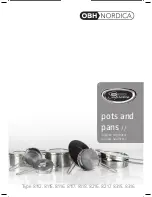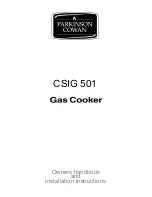
41
6
Cut It Up
One of the most important factors in successful dehydration is how foods are
sliced. When drying fruits, it helps to dry foods with the same moisture level at
the same time. The thicker the slice, the more moisture it holds. Therefore,
thick slices dehydrate slower than thin slices. While the thickness of your slices
is mostly a personal preference, it helps to attempt to keep all slices as close to
the same thickness as possible to ensure a consistent result.
The skin of many foods naturally protects it. This protective function can
hamper the dehydration process. During dehydration moisture escapes best
from a cut or broken surface, rather than through the tough skin. Therefore,
the bigger the surface area of the cut, the faster the food will dehydrate.
Loading the Drying Trays
When loading food onto the drying trays, it is important to maintain air flow.
Use as much of the surface area as possible, but make sure to keep the food in
a single layer. If some pieces are not fully dehydrated, it may be because they
were covered by other pieces of food.
Smaller pieces of food my shrink to the point of falling through the holes in the
drying trays. To prevent this, it is best to use the fruit leather trays for smaller
pieces.
UUSSIINNGG YYO
OUURR FFO
OO
ODD DDEEHHYYDDRRA
ATTO
ORR
Drying Time
It is difficult to give an exact drying time due to the numerous factors that come into
play. Such as:
• The moisture content of each food
• The thickness or size of food
• The humidity and temperature in the room where the dehydrator is
operating
• The density of the food
The food that is being dehydrated affects drying time as well. For instance, the age of
the food, where and how the food was grown, how it has been stored, and more all
are factors in dehydrating time. For hints look at the dehydrating guide, beginning on
page 15
.
PPRREEPPA
ARRA
ATTIIO
ONN TTIIPPSS
Herb-Flavored Fish Jerky
RREECCIIPPEESS
NOTE:
All fish
MUST
be cooked before drying. Steaming or roasting are the
best methods.
Makes approx. 2 lbs.
Don’t let the high amount of salt in these recipes scare you. It is necessary
to properly preserve the fish or “cure” it and to achieve the proper texture
when dried.
2 tbs. salt
1 tsp. dried celery flakes
¼
cup dried parsley flakes
½
tsp. crushed dried bay leaf
1 tsp. pepper
Use only very fresh and lean fish fillets. Fish high in oil, such as salmon or
smelt, do not dry as well.
Soak fish in salt brine solution for 30 minutes. Remove and rinse with cold
water; drain.
Mix salt with other dry ingredients. Rub fish strips with white wine and
sprinkle with salt mixture. Refrigerate for 6 hours.
Place cured fish on drying trays in a single layer. Dry at 145
º
for 12 to 14
hours, or until pliable, but not crumbly.
¼
tsp. dried thyme
2 tsp. onion powder
¼
cup dry white wine
4 lbs. lean fish fillets, cut into
¼
-inch
strips
Lemon Tahini Dressing
Makes 2
½
cups
This is a great way to use several different varieties of dehydrated
vegetables. Use this dressing on salads or as a sauce for whole grains, such as
brown rice.
1 cup vegetable oil
¼
cup lemon juice, or more to taste
¼
cup tamari or soy sauce
¼
cup rehydrated onion
Blend all ingredients with a blender or food processor until smooth. (The
NutriWare
™
Whole Food Blender
™
will easily blend these or nearly any other
foods. For more information, visit our website at
www.mynutriware.com
.)
Taste and add more lemon juice if desired. Store in a covered jar in the
refrigerator. Keeps for about 2 weeks.
¼
cup chopped rehydrated green bell
pepper
¼
cup chopped rehydrated celery
½
cup toasted sesame tahini







































